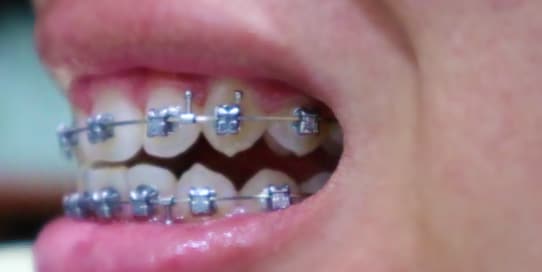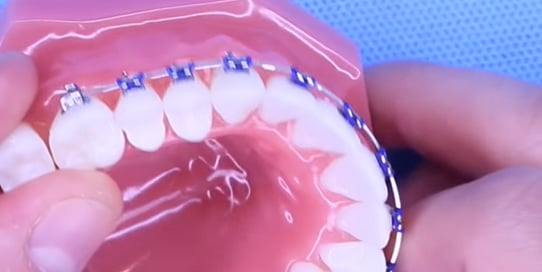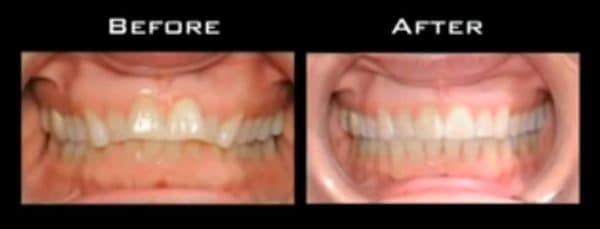
Are Damon braces really better than regular braces?
YES, they are better (but there are caveats). Below is a GIF of how the Damon braces can correct complex teeth crowding. Before I list the benefits of getting Damon braces, let’s discuss how these two orthodontic systems differ.
Traditional Metal Braces vs. Damon Braces
Contents
- Traditional Metal Braces vs. Damon Braces
- Metal braces – with ligatures
- Advantages of Traditional Braces
- What are the disadvantages of Traditional Braces?
- Damon braces – metal self-ligating brackets
- Cost of Traditional vs. Damon Braces
- Advantages of the Damon braces
- So – Why are Damon Braces a Better Choice Overall?
- Resources
Damon and traditional braces are two orthodontic treatment options that can help straighten teeth and correct bite issues. Here are some differences between Damon braces and traditional braces:
- Design: Traditional braces use metal brackets attached to the teeth with wires tightened over time to shift the teeth into place gradually. Damon braces also use metal brackets, but they have a unique sliding mechanism that allows the wires to move more freely and adjust more efficiently, potentially reducing the amount of discomfort and number of visits to the orthodontist.
- Appearance: Traditional braces are highly visible and can be noticeable when you smile, while Damon braces are designed to be less noticeable, with smaller brackets and less visible wires. Damon braces also come in clear or ceramic options that can be even less visible.
- Treatment time: Because of their unique design, Damon braces may be able to move teeth more quickly than traditional braces, potentially shortening the overall treatment time.
- Comfort: Because Damon braces use a unique sliding mechanism and don’t require the same level of tightening as traditional braces, they may be more comfortable to wear.
- Cost: Damon braces may be more expensive than traditional braces, although the overall cost will depend on factors like the length of treatment and your individual needs.
It’s important to note that both traditional and Damon braces can effectively correct many orthodontic issues. The best choice for you will depend on your individual needs and preferences. An orthodontist can help you determine which option is right for you.
| Criteria | Damon Braces | Traditional Metal Braces |
|---|---|---|
| Appearance | Uses clear brackets and small metal wires, which are less noticeable | Uses metal brackets and wires that can be more noticeable |
| Treatment Time | Generally shorter treatment time than traditional metal braces | Treatment time can vary but may take longer than Damon braces due to the need for more frequent adjustments |
| Discomfort | Can be more comfortable than traditional metal braces, as they use lighter forces to move teeth | Can cause more discomfort, particularly during adjustments or after the wires are tightened |
| Cost | Typically more expensive than traditional metal braces | Typically less expensive than Damon braces |
| Oral Hygiene | Easier to maintain good oral hygiene, as the brackets are easier to clean and there are no elastic ties to trap food | Requires extra care and attention to maintain good oral hygiene, as the brackets and elastic ties can trap food and make cleaning more difficult |
| Adjustments | Requires fewer adjustments than traditional metal braces, as the wires are self-ligating and don’t require elastic ties | Requires more frequent adjustments, as the wires need to be tightened manually and the elastic ties need to be replaced regularly |
| Suitability | Suitable for a wide range of orthodontic issues, including complex cases | Suitable for most orthodontic issues, but may not be as effective for complex cases or cases with severe bite problems |
Metal braces – with ligatures
Orthodontics is often related to the “metal mouth” patients’ looks. One of the “classical” ways to work on this treatment is to wear metal braces. These can have two systems to keep the brackets “closed”: by using elastic ligatures or by having them “close” themselves through a new system. The latter ones are called “self-ligating” braces, and we can give you the most famous type: Damon.

In this section, we’ll discuss the “old style” braces, which have no self-ligating system but are still widely used with excellent results. Even if they are not as “modern” as other orthodontic braces, their efficiency is good, and many patients have got excellent results and straight teeth now. This type will also help us understand how the braces work in the end to make us have that wonderful smile.
Here is how metal braces look. Some people mistake and call the entire system “brackets,” but the bracket is one of the elements that go on each tooth, while the entire “collection” of brackets, arches, and ligatures is what we call braces. We’ll also try to identify each element so that you can understand better:
- Archwire is the “wire” that holds all elements in place. The arch goes from left to right, and the brackets are connected. This element is of huge importance since it’s the one to “force” the teeth into their proper position together with the elastics. At first, the archwire looks “jagged” since the brackets are placed at the same distance from the end of the tooth. Since one tooth is placed higher than the other, the patient will have a “crooked” archwire. The wire tends to go to its original form, thus forcing the teeth to go up or down or rotate until they are all set.
- The ligatures – at this “classical” type of braces, the brackets don’t have their ligating system, so we need ligatures to ‘tie” them to the archwire. Many patients chose a rainbow of possible colors, thus making their braces look lovely. This is their chance to get creative.
- Bracket – this is the “jewel” that’s getting stuck on your teeth by using a strong “glue” (bonder). The bracket will take the force from the archwire and the elastics and “translate” it to the tooth. The brackets differ from tooth type to tooth, so they can all work together for a perfect smile.
- Elastics – these might get used to help with jaw problems. They can be worn some hours a day or permanently (this means a few weeks, so don’t get too scared). Many patients dislike them since they can speak with difficulty, and it’s not pleasant, but they are an essential part of their treatment, and it’s a good idea to stick to it. The results make it worth the effort.
- Together with these elements, your orthodontist might also use others: buttons, mini-molds, power chains, etc. This choice is based on your conditions and the complexity of your orthodontic case. The “arsenal” can be pretty serious for people with severe misalignments.
Advantages of Traditional Braces
- This is the less expensive treatment
- All orthodontists can work with this
- Most health insurance covers the treatment
- they are strong and hard to “break”
- they work very nicely, and the results are amazing
- you can already get gold-plated ones if you want to feel different
- the ligatures can look nice if you know how to blend the colors while making your braces less dull and impersonal
What are the disadvantages of Traditional Braces?
- such as in any metal brace type these braces are easy to spot
- some patients dislike the “metal mouth” look
- the ligatures can change color (due to eating or drinking), especially the white ones
- the first days in treatment are hard, but then it all solves nicely
- many patients have mouth sores because of the brackets, this gets solved with dental wax, and in some days, you won’t have this problem anymore
- there are more modern systems that would work faster or be more discreet
Still, for many orthodontic patients, the metal braces with those colorful ligatures do an excellent job. A huge percentage of the people who are into this treatment still use this system with excellent results. In the end, it’s not all about the braces; the patient is the one who can make or break a treatment.
Damon braces – metal self-ligating brackets
As I mentioned in the first section, the metal braces can be of 2 main categories: the braces with brackets that have their system to connect to the archwire (self-ligating) and the ones that need ligatures to do this. This article will present the self-ligating bracket braces, the best known being the Damon braces.

These are still metal braces, but with a revolutionary lighting system, excellent results, and in many cases, no need for extractions. The system was created by the orthodontist Dwight Damon.
In many cases, extractions are needed for adults who cannot wear palatal expanders (it’s useless since they are no more kids, their bone structure is now final). When the teeth are too big for the small mouth, the only way to make them “fit” is to extract some (usually, the first pre-molars are extracted, thus leaving enough space that will not show. The Damon System doesn’t require extractions all the time since it can solve problems without any teeth being pulled.
In my case, for instance, extractions were needed since my teeth were way too large for them to fit. In this case, the Damon braces needed these extractions, too, so that they can arrange the teeth properly. It all depends on your case and how your orthodontist sees your treatment.
The good thing about the Damon braces is they no longer need those colorful ligatures. Sure, they can be cute, but why use them if we can do without them? Damon thought this when he implemented the “sliding-doors” system on the brackets that close and open with no external help from ligatures.
The Damon braces have smaller brackets (there are already some partially ceramic ones), and they look pretty good. I haven’t worn braces on all teeth, but I saw many fully braced patients, and their braces looked nice. The small stainless steel brackets looked like tiny silver jewels on their teeth.
And, if you want a funny aspect, they attract the magnet. Yeah, I tried it too.
Cost of Traditional vs. Damon Braces
The cost of Damon braces and traditional braces can vary widely depending on several factors, including the severity of the orthodontic issues being treated, the length of treatment, and the location of the orthodontic practice.
In general, Damon braces tend to be slightly more expensive than traditional braces. This is because they use more advanced technology, and the brackets and wires are more expensive. However, the difference in cost between the two types of braces is usually insignificant.
According to the American Dental Association, the average cost of traditional braces is between $4,000 and $6,000. Damon braces are typically slightly higher, with an average cost of between $4,500 and $8,000.
It’s important to note that the cost of braces can vary widely depending on several factors, including the severity of the orthodontic issues, the length of treatment, and the location of the orthodontic practice. Additionally, many dental insurance plans offer coverage for orthodontic treatment, which can help offset the cost.
Advantages of the Damon braces
- the brackets are smaller and look pretty nice
- no ligatures mean fewer chances to catch all that food in there
- they work faster, and the results are sometimes astounding (in my case, I had an incisor move 7 mm in just 4 months)
- it’s a new system, and it’s getting improved constantly.
Disadvantages of Damon braces
- they are still metal braces and offer you that “metal mouth” look
- the treatment is more costly than in the “classical” braces case
- the orthodontists need to be accredited to use the system. For a list of them, please consult the official DAMON site.
- The treatment can be painful in the first days; you’ll also have mouth sores (treatable with dental wax).
Still, the Damon System is an excellent idea if you want a suitable metal braces orthodontic treatment. I used them for seven months in preparation for the Invisalign treatment, but the results were terrific.
So – Why are Damon Braces a Better Choice Overall?
The Damon braces cost more than the regular ones, and dental insurance might not cover this difference in some cases. For a doctor to be able to work with Damon, they need to be accredited. This would be another small setback since some orthodontists are not licensed to use this. Most top doctors have the certification, so it’s not a huge deal.
And now, back to the subject at hand: why the Damon braces are better than the regular ones.
No ligatures, smaller brackets.
The self-ligating system on the brackets makes Damon better. You don’t need ligatures on your brackets; they are smaller. Some are already partially “clear,” making it even harder to see. More discreet braces help with the aesthetics too.
Some patients don’t need extractions.
There are cases when the Damon system can solve the problem without extractions. Sure, even if they advertise this, it depends on the patient. The thing is that when regular braces required extractions, Damon might solve this without them. Still, there are patients with problems that can’t be solved other than having extractions. I was such a case. Damon solved my huge problems (rotating teeth, mispositioned teeth, not only misaligned), but they still needed the space to work (since I have big teeth).
Faster treatment.
Some claim Damon works half the time. I read about patients with regular braces who needed over 20 months of treatment for complex cases—even three years. If I had only wanted Damon, my problems would have been solved in 14 months. I saw HUGE progress in just weeks. After three times in the treatment, my teeth looked amazing already. Damon is a severe system, and the braces “don’t play”; they work.
Overall Damon is not as hard to wear.
After solving some sores in my mouth and getting past the first painful days (all braces do this, the pain means the treatment is working), I liked it. It might sound like I am a “masochist,” but it’s not that hard. The braces weren’t too big, and I could have almost an everyday life. And the Damon braces do look nice. I was initially scared about having a metal mouth (the reason I chose to wear Invisalign for my front teeth after the lateral ones were getting straightened with Damon), and I regretted this decision after seeing some patients who wore full Damon. They looked pretty nice as if they had some silver jewels on their teeth.
Damon braces are considered to be the “new generation” braces.
My orthodontist doesn’t use the regular ones for some years already. He’s using Damon, ceramics, Incognito, and Invisalign. I wore Damon 3 braces, and so did many of his patients. The Damon braces use the ideas that made the regular ones work excellent for years but offer faster results, with less “equipment” needed (not ligatures on the brackets), a better aspect, and more discreet brackets.
If you can afford Damon, I advise you to go on this route. Regular braces do work nicely, but Damon does work BETTER.
Resources
Here are some reputable sources and citations that you may find helpful for learning more about Damon braces and traditional braces:
- American Association of Orthodontists (AAO): The AAO is a professional orthodontist organization in the United States. Their website offers a wealth of information about orthodontic treatment, including Damon and traditional braces. https://www.aaoinfo.org/.
- American Dental Association (ADA): The ADA is a professional organization for dentists in the United States. Their website offers information on dental topics, including orthodontic treatment. https://www.ada.org/.
- Damon Braces: The official website of Damon Braces provides detailed information about the technology and benefits of their system, as well as a directory of orthodontists who offer Damon braces. https://damonbraces.com/.
- Orthodontics: Current Principles and Techniques, 6th Edition: This textbook by Thomas M. Graber, Robert L. Vanarsdall Jr., and Katherine W. L. Vig provides an in-depth look at the principles and techniques of orthodontic treatment, including traditional braces and Damon braces. This resource is often used by orthodontic professionals and is available for purchase on major book retailers’ websites.
These resources provide reliable information about Damon braces and traditional braces and can help you decide which braces may be right for you.


One Reply to “Are Damon braces really better than regular braces?”
At what age you have put the braces?